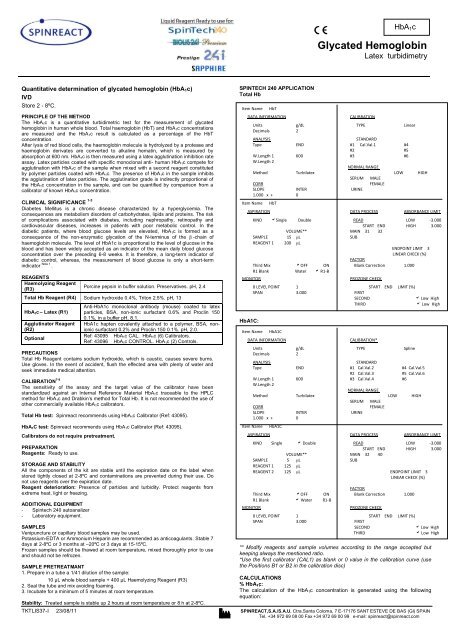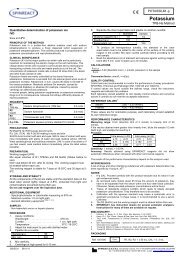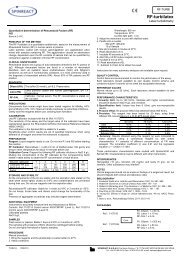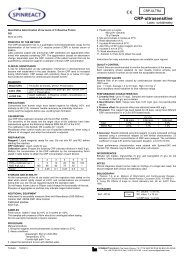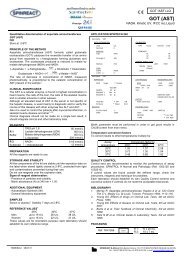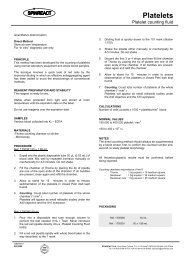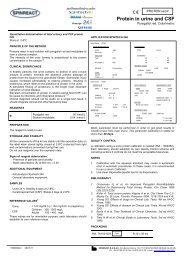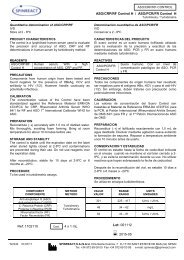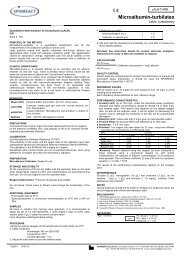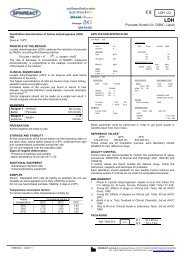nonionic
Tecnicas Ingles-Español Turbilatex - Spinreact
Tecnicas Ingles-Español Turbilatex - Spinreact
Create successful ePaper yourself
Turn your PDF publications into a flip-book with our unique Google optimized e-Paper software.
HbA 1 c<br />
Glycated Hemoglobin<br />
Latex turbidimetry<br />
Quantitative determination of glycated hemoglobin (HbAB1Bc)<br />
IVD<br />
Store 2 - 8ºC.<br />
PRINCIPLE OF THE METHOD<br />
The HbAB 1B c is a quantitative turbidimetric test for the measurement of glycated<br />
hemoglobin in human whole blood. Total haemoglobin (HbT) and HbAB 1B c concentrations<br />
are measured and the HbAB1Bc result is calculated as a percentage of the HbT<br />
concentration.<br />
After lysis of red blood cells, the haemoglobin molecule is hydrolyzed by a protease and<br />
haemoglobin derivates are converted to alkaline hematin, which is measured by<br />
absorption at 600 nm. HbAB 1B c is then measured using a latex agglutination inhibition rate<br />
assay. Latex particles coated with specific monoclonal anti- human HbAB1Bc compete for<br />
agglutination with HbAB 1B c of the sample when mixed with a second reagent constituted<br />
by polymer particles coated with HbAB 1B c. The presence of HbAB 1B c in the sample inhibits<br />
the agglutination of latex particles. The agglutination grade is indirectly proportional of<br />
the HbAB 1B c concentration in the sample, and can be quantified by comparison from a<br />
calibrator of known HbAB 1B c concentration.<br />
CLINICAL SIGNIFICANCE P 1-3<br />
Diabetes Mellitus is a chronic disease characterized by a hyperglycemia. The<br />
consequences are metabolism disorders of carbohydrates, lipids and proteins. The risk<br />
of complications associated with diabetes, including nephropathy, retinopathy and<br />
cardiovascular diseases, increases in patients with poor metabolic control. In the<br />
diabetic patients, where blood glucose levels are elevated, HbAB 1B c is formed as a<br />
consequence of the non-enzymatic glycation of the N-terminus of the -chain of<br />
haemoglobin molecule. The level of HbA1c is proportional to the level of glucose in the<br />
blood and has been widely accepted as an indicator of the mean daily blood glucose<br />
concentration over the preceding 6-8 weeks. It is therefore, a long-term indicator of<br />
diabetic control, whereas, the measurement of blood glucose is only a short-term<br />
indicator P Note 1 P .<br />
REAGENTS<br />
Haemolyzing Reagent<br />
(R3)<br />
Porcine pepsin in buffer solution. Preservatives. pH, 2.4<br />
Total Hb Reagent (R4) Sodium hydroxide 0.4%, Triton 2.5%. pH, 13<br />
HbAB 1B cB B– Latex (R1)<br />
Agglutinator Reagent<br />
(R2)<br />
Optional<br />
Anti-HbA1c monoclonal antibody (mouse) coated to latex<br />
particles, BSA, non-ionic surfactant 0.6% and Proclin 150<br />
0.1%, in a buffer pH, 8.1.<br />
HbA1c hapten covalently attached to a polymer, BSA, <strong>nonionic</strong><br />
surfactant 0.2% and Proclin 150 0.1%. pH, 2.0.<br />
Ref: 43095 HbAB 1B c CAL. HbAB 1B c (6) Calibrators.<br />
Ref: 43096 HbAB 1B c CONTROL. HbAB 1B c (2) Controls.<br />
PRECAUTIONS<br />
Total Hb Reagent contains sodium hydroxide, which is caustic, causes severe burns.<br />
Use gloves. In the event of accident, flush the effected area with plenty of water and<br />
seek immediate medical attention.<br />
CALIBRATIONP 7-9<br />
The sensitivity of the assay and the target value of the calibrator have been<br />
standardized against an Internal Reference Material HbAB 1B c traceable to the HPLC<br />
method for HbAB 1B c and Drabkin’s method for Total Hb. It is not recommended the use of<br />
other commercially available HbAB 1B c calibrators.<br />
Total Hb test: Spinreact recommends using HbAB 1B c Calibrator (Ref: 43095).<br />
HbAB 1B C test: Spinreact recommends using HbAB 1B c Calibrator (Ref: 43095).<br />
Calibrators do not require pretreatment.<br />
PREPARATION<br />
Reagents: Ready to use.<br />
STORAGE AND STABILITY<br />
All the components of the kit are stable until the expiration date on the label when<br />
stored tightly closed at 2-8ºC and contaminations are prevented during their use. Do<br />
not use reagents over the expiration date.<br />
Reagent deterioration: Presence of particles and turbidity. Protect reagents from<br />
extreme heat, light or freezing.<br />
ADDITIONAL EQUIPMENT<br />
- Spintech 240 autoanalizer<br />
- Laboratory equipment.<br />
SAMPLES<br />
Venipuncture or capillary blood samples may be used.<br />
Potassium-EDTA or Ammonium Heparin are recommended as anticoagulants. Stable 7<br />
days at 2-8ºC or 3 months at –20ºC or 3 days at 15-15ºC.<br />
Frozen samples should be thawed at room temperature, mixed thoroughly prior to use<br />
and should not be refrozen.<br />
SAMPLE PRETREATMANT<br />
1. Prepare in a tube a 1/41 dilution of the sample:<br />
10 µL whole blood sample + 400 µL Haemolyzing Reagent (R3)<br />
2. Seal the tube and mix avoiding foaming.<br />
3. Incubate for a minimum of 5 minutes at room temperature.<br />
Stability: Treated sample is stable up 2 hours at room temperature or 8 h at 2-8ºC.<br />
SPINTECH 240 APPLICATION<br />
Total Hb<br />
Item Name<br />
TKTLIS37-I 23/08/11 SPINREACT,S.A./S.A.U. Ctra.Santa Coloma, 7 E-17176 SANT ESTEVE DE BAS (GI) SPAIN<br />
Tel. +34 972 69 08 00 Fax +34 972 69 00 99 e-mail: spinreact@spinreact.com<br />
HbA1C:<br />
HbT<br />
DATA INFORMATION<br />
CALIBRATION<br />
Units g/dL TYPE Linear<br />
Decimals 2<br />
ANALYSIS<br />
STANDARD<br />
Type END #1 Cal.Val.1 #4<br />
#2 #5<br />
W.Length 1 600 #3 #6<br />
W.Length 2<br />
NORMAL RANGE<br />
Method Turbilatex LOW HIGH<br />
SERUM MALE<br />
CORR<br />
FEMALE<br />
SLOPE INTER URINE<br />
1.000 x + 0<br />
Item Name<br />
HbT<br />
ASPIRATION DATA PROCESS ABSORBANCE LIMIT<br />
KIND Single Double READ LOW -3.000<br />
START END HIGH 3.000<br />
VOLUME** MAIN 31 32<br />
SAMPLE 15 L SUB<br />
REAGENT 1 200 L<br />
ENDPOINT LIMIT 3<br />
LINEAR CHECK (%)<br />
FACTOR<br />
Third Mix OFF ON Blank Correction 1.000<br />
R1 Blank Water R1-B<br />
MONITOR<br />
PROZONE CHECK<br />
0 LEVEL POINT 1 START END LIMIT (%)<br />
SPAN 3.000 FIRST<br />
SECOND<br />
Low High<br />
THIRD<br />
Low High<br />
Item Name<br />
HbA1C<br />
DATA INFORMATION<br />
CALIBRATION*<br />
Units g/dL TYPE Spline<br />
Decimals 2<br />
ANALYSIS<br />
STANDARD<br />
Type END #1 Cal.Val.2 #4 Cal.Val.5<br />
#2 Cal.Val.3 #5 Cal.Val.6<br />
W.Length 1 600 #3 Cal.Val.4 #6<br />
W.Length 2<br />
NORMAL RANGE<br />
Method Turbilatex LOW HIGH<br />
SERUM MALE<br />
CORR<br />
FEMALE<br />
SLOPE INTER URINE<br />
1.000 x + 0<br />
Item Name<br />
HbA1C<br />
ASPIRATION DATA PROCESS ABSORBANCE LIMIT<br />
KIND Single Double READ LOW -3.000<br />
START END HIGH 3.000<br />
VOLUME** MAIN 32 40<br />
SAMPLE 5 L SUB<br />
REAGENT 1 125 L<br />
REAGENT 2 125 L ENDPOINT LIMIT 3<br />
LINEAR CHECK (%)<br />
FACTOR<br />
Third Mix OFF ON Blank Correction 1.000<br />
R1 Blank Water R1-B<br />
MONITOR<br />
PROZONE CHECK<br />
0 LEVEL POINT 1 START END LIMIT (%)<br />
SPAN 3.000 FIRST<br />
SECOND<br />
Low High<br />
THIRD<br />
Low High<br />
THIRD<br />
Low High<br />
** Modify reagents and sample volumes according to the range accepted but<br />
keeping always the mentioned ratio.<br />
*Use the first calibrator (CAL1) as blank or 0 value in the calibration curve (use<br />
the Positions B1 or B2 in the calibration disc)<br />
CALCULATIONS<br />
% HbAUBU 1UBU c:<br />
The calculation of the HbAB 1B c concentration is generated using the following<br />
equation:
HbA 1 c<br />
Glycated Hemoglobin<br />
Latex turbidimetry<br />
HbA c (g/dL)<br />
% HbA c 1<br />
1<br />
x100<br />
T.Hb(g/dL)<br />
QUALITY CONTROL<br />
HbAB 1B c Control (ref: 43096) is recommended to monitor the performance of<br />
manual and automated assay procedures. Controls require pretreatment after<br />
being reconstituted.<br />
Each laboratory should establish its own Quality Control scheme and corrective<br />
actions if controls do not meet the acceptable tolerances.<br />
REFERENCE VALUES<br />
Non-diabetics: Between 4-6%.<br />
Controlled diabetics: Between 6-8%.<br />
Uncontrolled diabetics: 20%.<br />
Each laboratory should establish its own reference range to reflect the age, sex,<br />
diet and geographical location of the population.<br />
INTERFERENCESP 10<br />
Bilirrubin (30 mg/dL), tryglicerides (1.6 g/dL) and rheumatoid factors (2000<br />
IU/mL), acetylsalicylic ac. (60 mg/dL), sodium cyanate (50 mg/dL) and urea (500<br />
mg/dL) do not interfere. The labile fraction of glycated hemoglobine does not<br />
interfere, as the antibody is specific for the stable ketamine. Other substances<br />
may interfere.<br />
NOTES<br />
1. Clinical diagnosis should not be made on findings of a single test result, but<br />
should integrate both clinical and laboratory data.<br />
2. Use ClNa 9g/L as a Calibrator 0.<br />
BIBLIOGRAPHY<br />
1. Wolf HU et al. Clin Chem Acta 1984; 136: 83-104.<br />
2. Nathan DM et al. Mne J Med 1094; 310: 341-346.<br />
3. Goldstain DE et al. Clin Chem 1986; 32: B64-B70.<br />
4. Ellis G et al. Clin Chem 1984: 30; 1746-1752.<br />
5. Kenneth H G et al. JCE and M 1977; 44 (5): 859 – 864.<br />
6. Sharp P at al. Ann Clin Biochem 2002; 39: 516 – 517.<br />
7. Middle J . Anna Clin Biochem 2002; 39: 534 – 537.<br />
8. Marshall SM et al. Ann Clin Biochem 2000; 37: 45-46.<br />
9. Young RJ. Ann Clin Biochem 2000; 37: 47-48.<br />
10.Young DS. Effects of drugs on clinical laboratory test, 4th ed. AACC Press, 1995.<br />
PACKAGING<br />
Cont.<br />
HbAB 1B c-Latex (R1)<br />
Agglutinator Reagent (R2)<br />
Haemolyzing Reagent (R3)<br />
Total Hb Reagent (R4)<br />
Ref: TK43090<br />
: 2 x 12.5 mL<br />
: 2 x 12.5 mL<br />
: 2 x 40 mL<br />
: 2 x 25 mL<br />
TKTLIS37-I 23/08/11 SPINREACT,S.A./S.A.U. Ctra.Santa Coloma, 7 E-17176 SANT ESTEVE DE BAS (GI) SPAIN<br />
Tel. +34 972 69 08 00 Fax +34 972 69 00 99 e-mail: spinreact@spinreact.com
HbA1c<br />
Hemoglobina Glicosilada<br />
Turbidimetría Látex<br />
Determinación cuantitativa de la hemoglobina glicosilada (HbA 1c)<br />
IVD<br />
Conservar a 2 - 8ºC.<br />
PRINCIPIO DEL MÉTODO<br />
La HbA 1c es un ensayo turbidimétrico para la cuantificación de hemoglobina glicosilada en<br />
sangre total humana. La concentración de HbA 1c se expresa como el porcentaje de<br />
concentración de hemoglobina HbA 1c sobre la hemoglobina total (THb) de la muestra.<br />
La molécula de hemoglobina liberada como consecuencia de lisis de los hematies, es<br />
hidrolizada por acción de una proteasa, y los derivados de hemoglobina resultantes se<br />
convierten en hematina alcalina, que presenta una absorción a 600 nm.<br />
La HbA 1c se mide utilizando un método de inhibición de la aglutinación de partículas de<br />
látex. Las partículas de látex recubiertas con anticuerpo monoclonal anti-HbA 1c compiten<br />
con la HbA 1c de la muestra cuando se mezclan con un reactivo constituido por partículas<br />
de polímero sensibilizadas con haptenos de HbA 1c. La presencia de HbA 1c en la muestra<br />
inhibe la aglutinación de las partículas de látex. El grado de aglutinación de las partículas<br />
es indirectamente proporcional a la concentración de HbA 1c de la muestra y puede<br />
cuantificarse por comparación con un calibrador de concentración de conocida.<br />
SIGNIFICADO CLÍNICO 1-3<br />
La Diabetes Mellitus es una enfermedad crónica caracterizada por la presencia de<br />
hiperglicemia en la sangre del paciente. Las consecuencias más inmediatas son los<br />
trastornos metabólicos de carbohidratos, lípidos y proteínas. El riesgo asociado a las<br />
complicaciones de esta enfermedad, entre las cuales se incluyen la nefropatía, retinopatía y<br />
enfermedades cardiovasculares, aumenta en pacientes con escaso control metabólico. En<br />
los pacientes diabéticos, donde los niveles de glucosa en sangre son elevados, la HbA 1c se<br />
forma como consecuencia de una glicosilación no enzimática del grupo N-terminal de la<br />
cadena de la molécula de hemoglobina. El nivel de HbA 1c es proporcional al nivel de<br />
glucosa en sangre y es ampliamente aceptado como un indicador de la media de<br />
concentración diaria de glucosa durante un periodo de tiempo de 6-8 semanas. Además,<br />
se le considera un indicador de control diabético a largo plazo, mientras que la<br />
concentración de glucosa es solo un indicador de corto plazo (Nota 1) .<br />
REACTIVOS<br />
Reactivo Hemolizante<br />
(R3)<br />
Reactivo Hb Total<br />
(R4)<br />
HbA1c – Látex (R1)<br />
Reactivo Aglutinante<br />
(R2)<br />
Opcional<br />
Pepsina porcina en solución tampón. Conservantes. pH, 2,4.<br />
Sodio hidróxido 0.4%, Triton 2,5%. pH, 13.<br />
Partículas de látex sensibilizadas con anticuerpo monoclonal<br />
anti-HbA 1c (ratón), BSA, detergente 0,6% y Proclin 150<br />
0,1%, en tampón. pH, 8,1.<br />
Haptenos de HbA1c covalentementa unidos a un polímero,<br />
BSA, detergente 0,2% y Proclin 150 0,1%. pH, 2,0.<br />
Ref: 43095 HbA 1c CAL. Calibradores (6) de HbA 1c.<br />
Ref: 43096 HbA 1c CONTROL. Controles (2) de HbA 1c.<br />
PRECAUCIONES<br />
El Reactivo de Hb Total, contiene sodio hidróxido, que es cáustico, y causa quemaduras.<br />
Utilizar guantes. En caso de accidente, lavar el área afectada con abundante agua y<br />
solicitar la ayuda de un médico.<br />
CALIBRACION 7-9<br />
La sensibilidad del ensayo así como los valores de los calibradores han sido<br />
estandarizados con un Material de Referencia Interno, trazable a un método de HPLC para<br />
la HbA 1c y al método de Drabkin’s para la Hb Total.<br />
No es recomendable el uso de otros calibradores de HbA 1c comerciales.<br />
Ensayo de Hb Total: Spinreact recomienda usar el Calibrador de HbA 1c (Ref: 43095) para<br />
la calibración.<br />
Ensayo de HbA 1C: Spinreact recomienda usar el Calibrador de HbA 1c (Ref: 43095) para la<br />
calibración.<br />
Los Calibradores no necesitan pretratamiento.<br />
PREPARACIÓN<br />
Reactivos: Listos para el uso.<br />
CONSERVACIÓN Y ESTABILIDAD<br />
Todos los componentes del kit son estables hasta la fecha de caducidad indicada en el<br />
envase cuando se mantienen los viales bien cerrados a 2-8ºC, y se evita la contaminación<br />
durante su uso. No utilizar reactivos que hayan sobrepasado la fecha de caducidad.<br />
Indicadores de deterioro de los reactivos: Presencia de partículas y turbidez. Proteger<br />
los reactivos de temperaturas extremas, luz y congelación.<br />
MATERIAL ADICIONAL<br />
- Autoanalizador Spintech 240<br />
- Equipamiento habitual de laboratorio.<br />
MUESTRAS<br />
Se puede usar sangre venosa o capilar.<br />
Se recomienda utilizar EDTA potásico o Heparina amónica como anticoagulantes. Estable<br />
7 días a 2-8ºC ó 3 meses a –20ºC.<br />
Las muestras congeladas deberán descongelarse a temperatura ambiente, y<br />
homogenizarse ligeramente antes de usar.<br />
TRATAMIENTO DE LA MUESTRA<br />
1. Preparar en un tubo una dilución 1/41 de la muestra en Reactivo Hemolizante:<br />
10 µL sangre total + 400 µL Reactivo Hemolizante (R3)<br />
2. Tapar el tubo y agitar suavemente evitando la formación de espuma.<br />
3. Incubar un mínimo de 5 minutos a temperatura ambiente.<br />
Estabilidad: La muestra tratada es estable 2 horas a temperatura ambiente o 8 horas a<br />
2-8ºC.<br />
APLICACIÓN AL SPINTECH 240<br />
Hb Total:<br />
Item Name<br />
HbT<br />
DATA INFORMATION<br />
CALIBRATION<br />
Units g/dL TYPE Linear<br />
Decimals 2<br />
ANALYSIS<br />
STANDARD<br />
Type END #1 Cal.Val 1 #4<br />
#2 #5<br />
W.Length 1 600 #3 #6<br />
W.Length 2<br />
NORMAL RANGE<br />
Method Turbilatex LOW HIGH<br />
SERUM MALE<br />
CORR<br />
FEMALE<br />
SLOPE INTER URINE<br />
1.000 x + 0<br />
Item Name<br />
HbT<br />
ASPIRATION DATA PROCESS ABSORBANCE LIMIT<br />
KIND Single Double READ LOW -3.000<br />
START END HIGH 3.000<br />
VOLUME** MAIN 31 32<br />
SAMPLE 15 L SUB<br />
REAGENT 1 200 L<br />
ENDPOINT LIMIT 3<br />
LINEAR CHECK (%)<br />
FACTOR<br />
Third Mix OFF ON Blank Correction 1.000<br />
R1 Blank Water R1-B<br />
MONITOR<br />
PROZONE CHECK<br />
0 LEVEL POINT 1 START END LIMIT (%)<br />
SPAN 3.000 FIRST<br />
SECOND<br />
Low High<br />
THIRD<br />
Low High<br />
Item Name<br />
HbA1C<br />
DATA INFORMATION<br />
CALIBRATION*<br />
Units g/dL TYPE Spline<br />
Decimals 2<br />
ANALYSIS<br />
STANDARD<br />
Type END #1 Cal.Val.2 #4 Cal.Val.5<br />
#2 Cal.Val.3 #5 Cal.Val.6<br />
W.Length 1 600 #3 Cal.Val.4 #6<br />
W.Length 2<br />
NORMAL RANGE<br />
Method Turbilatex LOW HIGH<br />
SERUM MALE<br />
CORR<br />
FEMALE<br />
SLOPE INTER URINE<br />
1.000 x + 0<br />
Item Name<br />
HbA1C<br />
ASPIRATION DATA PROCESS ABSORBANCE LIMIT<br />
KIND Single Double READ LOW -3.000<br />
START END HIGH 3.000<br />
VOLUME** MAIN 32 40<br />
SAMPLE 5 L SUB<br />
REAGENT 1 125 L<br />
REAGENT 2 125 L ENDPOINT LIMIT 3<br />
LINEAR CHECK (%)<br />
FACTOR<br />
Third Mix OFF ON Blank Correction 1.000<br />
R1 Blank Water R1-B<br />
MONITOR<br />
PROZONE CHECK<br />
0 LEVEL POINT 1 START END LIMIT (%)<br />
SPAN 3.000 FIRST<br />
SECOND<br />
Low High<br />
THIRD<br />
Low High<br />
THIRD<br />
Low High<br />
HbA1C:<br />
** Modificar los volúmenes de reactivos y muestra en función de los rangos<br />
aceptados pero manteniendo siempre el ratio descrito anteriormente.<br />
* Usar el Calibrador 1 como blanco o valor 0 en la curva de calibración (utilizar la<br />
posición B1 o B2 en el disco de calibración)<br />
CALCULOS<br />
% HbA 1c:<br />
El cálculo del porcentaje de HbA 1c se efectúa mediante la siguiente fórmula:<br />
TKTLIS37-E 23/08/11 SPINREACT,S.A./S.A.U. Ctra.Santa Coloma, 7 E-17176 SANT ESTEVE DE BAS (GI) SPAIN<br />
Tel. +34 972 69 08 00 Fax +34 972 69 00 99 e-mail: spinreact@spinreact.com
HbA1c<br />
Hemoglobina Glicosilada<br />
Turbidimetría Látex<br />
%HbA1<br />
c<br />
HbA1c(g/dL)<br />
x100<br />
T.Hb(g/dL)<br />
CONTROL DE CALIDAD<br />
Se recomienda utilizar sueros control para controlar los ensayos tanto en<br />
procedimiento manual como en automático. Spinreact dispone de sueros control<br />
HbA 1c (Ref: 43096). Los Sueros Control precisan tratamiento previo de la<br />
muestra después de su reconstitución.<br />
Cada laboratorio debería establecer su propio Control de Calidad y establecer<br />
correcciones en el caso de que los controles no cumplan con las tolerancias<br />
exigidas.<br />
VALORES DE REFERENCIA<br />
No-diabéticos: Entre 4-6%.<br />
Diabéticos controlados: Entre 6-8%.<br />
Diabéticos no controlados: 20%.<br />
Es recomendable que cada laboratorio establezca sus propios valores de referencia.<br />
INTERFERENCIAS 10<br />
Bilirrubina (30 mg/dL), trigliceridos (1,6 g/dL), factores reumatoides (2000 UI/mL), ac.<br />
acetilsalicílico (60 mg/dL), cianato sódico (50 mg/dL) y urea (500 mg/dL) no<br />
interfieren. La fracción lábil de la hemoglobina glicosilada no interfiere ya que el<br />
anticuerpo es específico de la ketamina estable. Otras sustancias pueden interferir 10 .<br />
NOTAS<br />
1. El diagnóstico clínico no debe realizarse únicamente con los resultados de un<br />
único ensayo, sino que debe considerarse al mismo tiempo los datos clínicos del<br />
paciente.<br />
2. Utilizar ClNa 9 g/L como Calibrador 0.<br />
BIBLIOGRAFÍA<br />
1. Wolf HU et al. Clin Chem Acta 1984; 136: 83-104.<br />
2. Nathan DM et al. Mne J Med 1094; 310: 341-346.<br />
3. Goldstain DE et al. Clin Chem 1986; 32: B64-B70.<br />
4. Ellis G et al. Clin Chem 1984: 30; 1746-1752.<br />
5. Kenneth H G et al. JCE and M 1977; 44 (5): 859 – 864.<br />
6. Sharp P at al. Ann Clin Biochem 2002; 39: 516 – 517.<br />
7. Middle J . Anna Clin Biochem 2002; 39: 534 – 537.<br />
8. Marshall SM et al. Ann Clin Biochem 2000; 37: 45-46.<br />
9. Young RJ. Ann Clin Biochem 2000; 37: 47-48.<br />
10.Young DS. Effects of drugs on clinical laboratory test, 4th ed. AACC Press, 1995.<br />
PRESENTACIÓN<br />
Cont.<br />
HbA 1c-Látex (R1)<br />
Reactivo Aglutinante (R2)<br />
Reactivo Hemolizante (R3)<br />
Reactivo Hb Total (R4)<br />
Ref: TK43090<br />
: 2 x 12.5 mL<br />
: 2 x 12.5 mL<br />
: 2 x 40 mL<br />
: 2 x 25 mL<br />
TKTLIS37-E 23/08/11 SPINREACT,S.A./S.A.U. Ctra.Santa Coloma, 7 E-17176 SANT ESTEVE DE BAS (GI) SPAIN<br />
Tel. +34 972 69 08 00 Fax +34 972 69 00 99 e-mail: spinreact@spinreact.com


